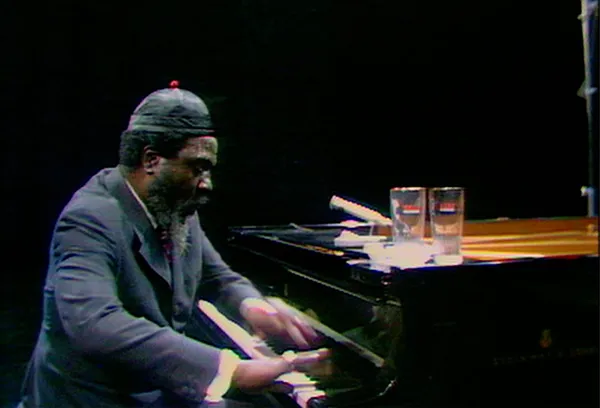Alain Gomis’s enthralling and insightful Rewind & Play: it’s not nice (a highlight in the Currents programme of the 60th New York Film Festival), produced by Arnaud Dommerc (Andolfi) and Anouk Khélifa (Sphere Films), opens with the arrival of Thelonious Monk (composer for Roger Vadim’s Les liaisons dangereuses) and his wife, Nellie, in Paris on December 15, 1969, for a concert at the Salle Pleyel.
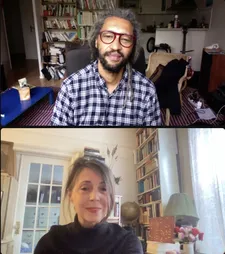 |
| Alain Gomis with Anne-Katrin Titze on Thelonious Monk and Henri Renaud: “It’s like two planets that never meet …” |
Monk’s next stop is the set in a Montmartre recording studio for the French television program Jazz Portrait. He is scheduled for a performance and an interview with Henri Renaud. We see the great composer and pianist becoming more and more uncomfortable with the goings-on around him before the taping of the show. The host, Renaud, starts to try to manipulate and downplay Thelonious Monk’s concerns of being underpaid for a European tour he was on and not being able to bring over the musicians he usually played with. Monk says he eventually got guys to play with him and he was the lowest paid even though his image was on the cover of the tour program. His silences and incredulous looks of disbelief in response to questions speak volumes.
Throughout the 65-minute documentary, put together by Alain Gomis with footage from the French National Archive Institute, Thelonious Monk maintains his dignity. He breathtakingly performs in part his compositions Reflections; Epistrophy; Ugly Beauty; Coming on the Hudson; Monk’s Mood; Crepuscule with Nellie; Thelonious; Round Midnight, plus George and Ira Gershwin’s Nice Work If You Can Get It; Sammy Cahn, Axel Stohrdahl, and Paul Weston’s I Should Care; Beth Slater Whitson and Leo Friedman’s Meet Me In Dreamland, and Dorothy Fields and Jimmy McHugh’s Don’t Blame Me.
From Paris, Alain Gomis joined me on Zoom for an in-depth conversation on Thelonious Monk in Rewind & Play.
Anne-Katrin Titze: Hello Alain! Where are you?
Alain Gomis: Hi, I’m in my office in Paris.
AKT: What a terrific film! Maybe we should start with the title, Rewind and Play. It is important to do precisely that, to look at the past in detail and see what we can take for the present. How did you feel when when you first saw this footage?
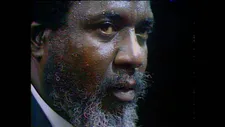 |
| Alain Gomis on Thelonious Monk: “Every piece of himself goes into it.” |
AG: I was surprised in fact. First of all it was a surprise to have access to this. I was supposed to receive a package from the National Archive Institute. I had asked them to send me what they got on Thelonious Monk. They sent me several TV shows and concerts they had that he did at the time in France. I knew this show [Jazz Portrait] already but was surprised that in fact they sent me the whole footage of it, the rushes. I was happy to see him out of the editing, outside of what is usually kept in this kind of program.
AKT: Yes, all of what is not in the broadcast, what is not to be shown is so interesting.
AG: Yes exactly. Especially for him, you know. He had an image; he was being marketed a special way as the weird guy, the weird genius and all that kind of stuff. It was interesting to see him fighting against this. There were the two sides of it. Maybe that was the way to make him be able to work and feed his family. But the other way it’s very difficult for him to hear this kind of question a hundred times.
AKT: Of course, very understandably so.
AG: I was just happy at the beginning to see him out of this.
AKT: Out of the box. It’s fascinating to see how with every pore, every drop of sweat his body refuses to have this happen to him again and again. Of being put in this horrible box of television, white television.
 |
| Thelonious Monk playing before the French TV show Jazz Portrait |
AG: This guy, Henri Renaud, [the interviewer] is also a jazz pianist. And I think he really loves the work of Monk, he loves Monk as a musician, but at the same time he feels so confident about the fact that he knows him. Maybe he considers him as a friend, maybe he thinks he knows the kind of life this guy is living. Yes, painting, music, all different kinds of art can touch your heart. But when it comes to things that you understand, the daily life of the artist, that’s something very different.
AKT: I didn’t know Henri Renaud at all and was actually surprised that he was a musician. He doesn’t come across that way. He does come across as a TV interviewer. Asking that almost unbearable question about the piano in the kitchen!
AG: Yeah.
AKT: You capture this well by your placement in the film and how it’s repeated. Monk clearly states that these were the circumstances and there is Renaud trying to construct some storytelling magic tricks around it.
AG: Yes, it’s like two planets that never meet in fact. He has a very romantic vision of what could be the life of a musician. It comes certainly from his own context of a French, maybe more bourgeois pianist.
AKT: Exactly.
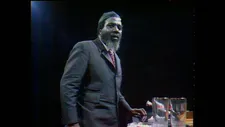 |
| Alain Gomis on Thelonious Monk: “He reacts with silence, with a lot of calm.” |
AG: There is this kind of Dandy freedom to choose, kind of romantic to have your piano in your kitchen. But the truth for Monk was just that it was the one room big enough to have this piano in his apartment. At the end I think we can see how much it’s painful. And we live a painful moment with Thelonius Monk going through that. I remember his son saying to me: ”I didn’t know what he had to go through in order to feed us.” It is painful because from the beginning, from the airport to the studio you can see how the people look at him.
How it is to be a big black guy coming to Paris with a camera and everyone asking who is this guy. When you have to live this every day - we can try to imagine what it is like to have to answer this kind of stupid question and to have these kinds of stereotypes over and over. And especially with someone who loves what you do! He’s not even an enemy, he’s friendly.
AKT: The frustration is so clear. At the 58th New York Film Festival there was the short [Terence Dixon’s Meeting the Man: James Baldwin in Paris, shot by Jack Hazan] of James Baldwin in Paris, I am sure you have seen, where you can feel a similar kind of frustration. When Monk talks about being paid less than everyone else, he is so clear and to the point and real. Far too real for television.
AG: Yes, that’s where he can be considered as weird in a way because he’s just honest. Which is very difficult to be with the media. He will never play the game of answering to a question he found stupid. He will say what he thinks.
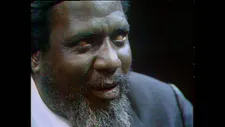 |
| Alain Gomis on Thelonious Monk: “He will never play the game of answering to a question he found stupid.” |
AKT: “Say something in French!” “Merci beaucoup,” he says. It’s so great.
AG: Exactly! He’s doing his work. He has to be there so he’s doing his job. The thing he wants to do - “just let me play!” At one point he’s a little bit upset and says “let’s stop all that, it’s about music, let me play music.” I think it’s not that different today. First, Henri Renaud really thinks he is part of the modern people, open-minded people. This is also what is disturbing watching the film, because we can watch ourself.
On the other side you have this incredible and beautiful man who could have been much more aggressive or violent because the situation is really unpleasant. He reacts with silence, with a lot of calm. He’s really nice, he’s doing the job, and even at the end after playing four beautiful tunes with a lot of energy, we can see what it is to play piano for him. It’s not that easy.
AKT: The words that came to mind were dignity and sweat. It’s such a remarkable combination that we never see. Dignity and sweat - I don’t know who else I could think of.
AG: Yeah, he put himself entirely into it. Every piece of himself goes into it. It’s really beautiful to see him like this and after four or five tunes you have this guy coming back saying “You know, can you do another one?” It’s crazy!
AKT: I want to ask you about your editing of the footage. You say every piece of him, I noticed that after 50 minutes we see his shoes for the first time. Tell me a bit about your decision making in the editing; what to repeat, what not to repeat!
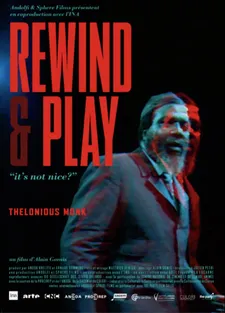 |
| Rewind & Play poster |
AG: I had done a lot of research on Thelonius Monk and read a lot of books, so I had access to some testimony and things that made me able to understand a little bit more, I think. But I’m subjective too. I wanted to try and make a kind of switch. When you have archival footage, you have a point of view, the point of view of the people who have done it at that time.
So I wanted to switch it a little bit and have the point of view of Thelonius Monk, just to give the kind of taste of what these days had been like for him. Sometimes I decided to go back a little bit to show something that we have seen before. I didn’t want to use any kind of voiceover.
AKT: Great decision.
AG: You’re coming into it and experience with him. Sometimes when you see something for the first time, you need a second time. And a third time. And every time you see the same thing differently. I wanted flashbacks to moments we have seen before to also remind us of Thelonius Monk before he came to the studio.
The editing was very fun to do, trying to find it inspired by the music of Thelonius Monk himself. He never used straight lines, he’d break the lines. And into the lines he put some holes. That’s what he teaches me until today. The truth is in the holes. You don’t have to try to catch, just let the thing happen. For that you don’t have to draw a beautiful line because you will always miss something.
So I try to tell a story using what Thelonius Monk taught me. He is a great artist, not only because he’s a good pianist, but I can compare him to Paul Cézanne, the painter. Some people are a game changer. He has been able to bring new laws in some ways and allow a new generation to be modern. In breaking this straight line and building the whole thing with pieces. The mastership he had in how to deal with these pieces and the distance between two pieces is in fact incredible. It was beautiful also to see this artist. He wanted to play because that’s for him the only way to get you in touch with what he is trying to put you in touch with. Nothing can be said, you know what I mean?
AKT: I do.
AG: He can’t say what is really important, you have to feel it. When you see him trying to deal with that kind of interview, that’s the two planets I was talking about before.
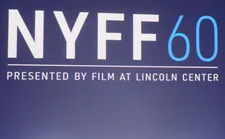 |
| The 60th New York Film festival Photo: Anne-Katrin Titze |
AKT: While you were talking I imagined floating sheets of ice and you have to jump from one to the other. There’s water in-between, which would perhaps also carry you. Sometimes you have to jump back to the ice float you came from in order to go forward. That’s also beautiful about your title which keeps reverberating in my head.
Sometimes in documentaries, or in films in general, you want to go back to what you’ve seen before because you didn’t understand. You fulfil this wish. I noticed also the subtitle: “it’s not nice?” This is being asked, and turns out to be exactly the question. It’s not nice to whom? Not nice from whom? And it’s not nice about what? It breeds other questions.
AG: You’re absolutely right! When Henri Renaud the interviewer asks Thelonius Monk to tell him about his first time in France in 1954, the only thing Thelonius Monk wants to say and recalls is that at this time he got paid less than the others and the conditions were bad. He didn’t have his musicians and had to play with people he never met before.
And the interviewer decided to say to the director who can hear and see him say, okay we won’t sell it. We see that. It happened two times. He asks the same question again and Monk gives the same answer again. Even if Monk doesn’t understand French he understands that something is happening. He is a little upset, we see him get up and walk out of the field of the camera, and we see Henri Renaud take him back. And then there is no sound at this moment. That’s also where I like this footage because the sound engineer decided at this moment to put the sound on again!
AKT: Yes!
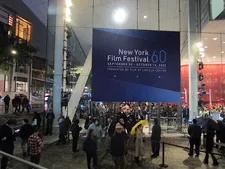 |
| Alice Tully Hall - 60th New York Film Festival Photo: Anne-Katrin Titze |
AG: He was not obliged to do this! Because at this moment it’s off and he turns it on again so we can hear the end of this little argument. And Monk says something incredible at this moment. He says: ”The first time I came to France, I was ossified all the time I was here.” And he says it with so much honesty. It’s beautiful to be able to say something like that. And the only answer is oh, yeah, but we don’t talk about that. Monk says “Why?” And he says “Yeah, but it’s not nice.” And Monk says “It’s not nice?” And yes, who is talking at this moment?
Us today watching this film, we can realize how crazy it is to say that. But at this moment - and it happens every day until today - there’s people who will say to us, to you, to somebody “This is not nice.” What is not nice? That’s the entire world he is living at this moment. It’s so incredibly violent. This guy says this to him just for telling the truth. But we are still able to be in this position, thinking, okay, I’m the open guy. We could talk about gender or whatever, it’s a kind of game that is happening every day. That’s why I love that footage. It’s from 1969 and it’s happening everyday today.
AKT: It is completely of the present. You are working on another Monk project?
AG: Yes, on a fiction, that’s why I was looking for everything I could find and had the chance to see this. Once I saw this I wanted to share it with everybody.
AKT: Thank you for that. It’s great.
AG: Thank you, have a good day!
Rewind & Play opens exclusively at the Brooklyn Academy of Music Rose Cinemas on Friday, March 10.








